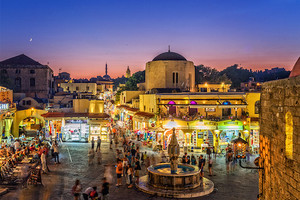
The Greek Islands has become synonymous with great beaches, wonderful food, unique wines, friendly people, and a fascinating and rich history which is heavily influenced by its maritime surroundings. And for many people, a cruise is a best way to see the region’s top highlights, which almost always feature on Eastern Mediterranean or specific Greek Island cruises. While two of the most popular destinations include Santorini in The Cyclades, and Rhodes in the Dodecanese group, which we covered in parts one and two of this feature, the capital of Greece, Athens, is often featured, or a departure for many of these cruises. And if it’s on your itinerary, here’s what you can expect to see and do.
As the cradle of western democracy and culture, Athens’ legacy makes it one of the most important cities in the world and fortunately much of the physical evidence of this remains as well and is being preserved for future generations. This is where government, law, architecture, philosophy, science, medicine, religion and the arts were formed, along with the more basic concept of civic life, and walking the streets of this modern city reveals this is where the building blocks of western society were laid.
Athens serviced by the ancient port of Piraeus, which at just 12km from the city centre appears to have seamlessly merged with the metropolis, and these days Athens is one of the most popular destinations on cruise ship itineraries in the Mediterranean, not just for its superb ancient monuments and museums, but also for its bustling outdoor cafe and restaurant scene which thrives on a refreshing attitude that life is for living, and work is just a means to an end. On the surface the city can resemble a chaotic mass of unplanned buildings, and heavy traffic in parts often causes smog, but in the heart of Athens major historical sites and dining and entertainment areas are linked by pedestrianised areas which provide an escape from the vehicular madness.
Standing sentinel over Athens, and dominating the cityscape from miles around, is the the famous rocky crag known as the Acropolis. The 70 metre high limestone fortress is the greatest symbol of the Classical Era with a multitude of monuments and artistic creations including the Parthenon, the greatest and most dramatic Doric Temple ever built. Completed in the 5th Century BC when the city was at is peak during the golden age of Perikles, the Parthenon was dedicated to the goddess of the city, Athena, and today it remains the unmistakeable symbol of Athens and is perhaps the most important monument in Europe. It is undergoing a major restoration which began in 1983 which will continue indefinitely, and despite the scaffolding, its splendour remains, and as the poet Ralph Waldo Emerson wrote: “Earth proudly wears the Parthenon as the best gem upon her zone.”
Within the Acropolis are at least half a dozen ancient masterpieces including the Erechtheion, a temple built in honour of both Athena and Poseidon, who according to mythology, battled for patronage of Athens on that spot, the Temple of Athena Nike, the Propylaia or entrance to the Acropolis, the 17,000-seat Theatre of Dionysus and the Herodes Atticus Theatre. At the foot of the Acropolis are the districts of Plaka and Monastiraki which are made up of small winding streets which are a delight to wander. Plaka is an historic area which has been gentrified over the past two decades with restored 19th century neoclassical homes, pedestrian streets, cafes, restaurants and tavernas which serve typical Greek specialties including moussaka, shish kebabs and souvlaki. Most visitors to Athens spend most of their time simply basking in the glory of the Acropolis from an alfresco table in the area and bypass the option of other attractions close by including the Ancient Agora and the changing of the guard at the Greek Parliament in Syntagma Square.
Greece is famous for many things including great philosophers, the Acropolis, ouzo and the larger than life popular singer, Demis Roussos. But one thing it isn’t especially famous for is internationally respected wine, yet it may surprise many people to learn that Greece is actually one of the oldest wine-producing regions in the world. And visiting Athens is a wonderful opportunity to try a lineup of varieties on offer. The origins of wine making go back some 6,500 years, and the expansion of Greek civilisation and their worship of Dionysus, the great god of wine, spread rapidly throughout the Mediterranean during the period of 1600 BC to the year 0. As a result, wine has been an important and integral part of Greek culture for over 4000 years. One of the things which makes Greek wines so unique is that there are more than 300 indigenous grape varieties grown in the country, both red and white, which produce a large number of highly distinctive flavours. One of the most well-known wine varieties is retsina, which became a national beverage during the 1960’s, and is regarded by many as a defining part of the Greek wine culture. There are a number of wine growing regions in Greece, the primary ones being in the Aegean Islands including Crete, Rhodes and Santorini, Central Greece, Kefalonia in the Ionian Islands, Macedonia and Peloponnesus.
- By:
- Ben Hall
Reviews
-
Apart From Hawkers.....
Hubby and I went to Greece for our honeymoon - he has family from there. We loved Athens but it was super hot, shame on us for going in July, but the hawkers outside bars and restaurants got on our nerves a bit :) We also explored some of the islands and loved it. I could see myself living there one day with our menagerie of cats and dogs :)









